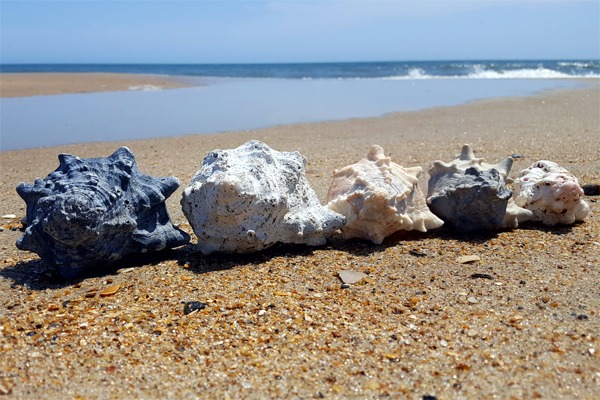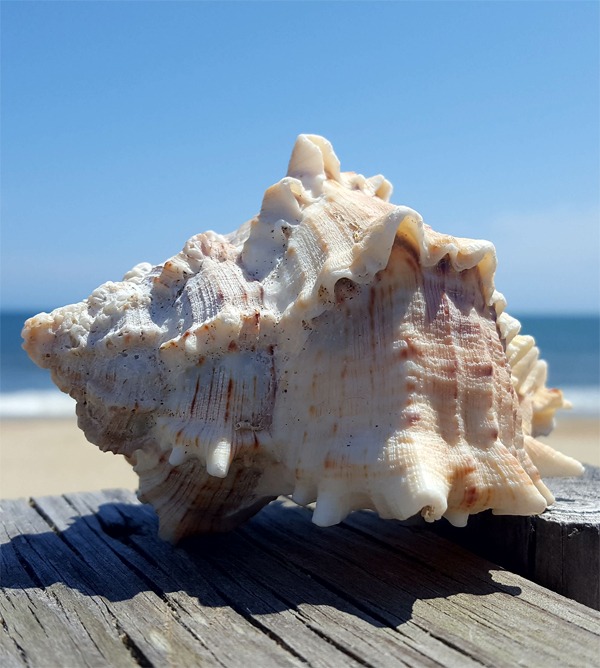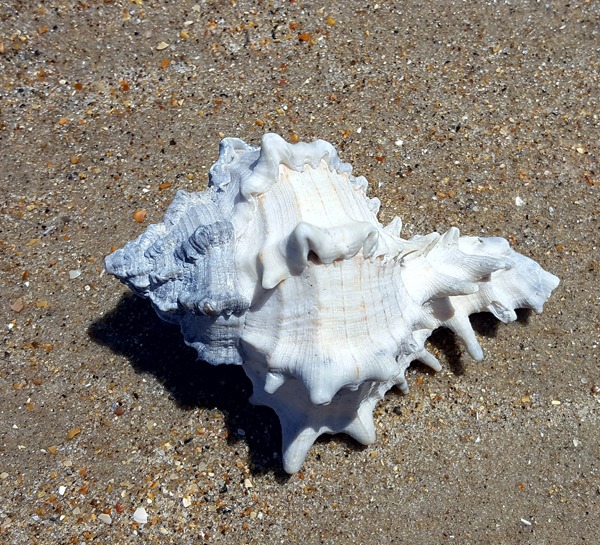
As a professional beachcomber, seashell enthusiast, and ocean-loving artist, my love for the beach runs deep. If I find something rare or unique, I usually can’t contain my excitement, and I end up doing a dance and singing a song. I like picking popular songs and replacing the key words with beach-themed words. So for this article, I used the Salt-n-Pepa song “Let’s Talk about Sex” and decided to sing about Murex shells instead. It goes a little something like this:
“Let’s talk about Murex, baby
Let’s talk about shells and me
Let’s talk about all the good things
and the bad things these shells can bring
Let’s talk about Murex
Let’s talk about Murex…”
So, let’s talk about the locally rare seashells known as Murex!
The Murex is a spiny and spiked seashell which has a funky shape, and these spikes make it a prized treasure for any dedicated shell enthusiast.
The spikey ridges are usually irregular in formation, because the Murex grows in stages known as episodic growth. The shell of a murex looks almost out of control compared to most shells which are more uniform and smooth in their structure, like the Scotch Bonnet.
Aristotle was the first to record the term Murex. The shell was identified in the Mediterranean, and it was used to dye fabrics purple, thus making the Murex one of the oldest historically recorded seashells.

Murex shells belong to the very large class of seashells known as Gastropods, and are a part of the Muricidae family. The Muricidae family is very large and diverse with over 1,200 species recorded, and an equal number of fossils discovered. Up until the past decade, shells found in the Indo-Pacific and the Atlantic Ocean Muricidae family were classified as the genus Murex, but now research suggests there should be a separate genus.
The Muricidae shells found in the Atlantic Ocean are now classified in the Haustellum genus. Albeit extremely similar in their structure and diet, the shells found in the Atlantic have their differences compared to the ones found in the Indo-Pacific region. More research is still needed to make this distinction universally accepted, which is always challenging for scientists, because seashells are nocturnal, and studying them in their natural environment can be extremely challenging and dangerous.
For the sake of this article, we are going to refer to the Muricidae Gastropod shells that can be found in the Atlantic as Murex shells. There are several that can make special, rare appearances on the coast of the Outer Banks.
The Apple Murex is probably the most common, as it tends to be the thickest. Its thickness makes it withstand the violent force the shores of the Outer Banks are known to have. The spikes are smoother than the other varieties, and these shells tend to be grayish to brownish in coloring.
Similar to the Apple Murex, but smaller in size and not as thick, is the Pitted Murex. It is usually prettier in color with shades of pink and greys. The spines on the Pitted Murex are smooth and less noticeable compared to all of the others.
The Lace Murex and the Lightweight Murex are the rarest to find along the Outer Banks. The Lightweight Murex, like the Pitted Murex, is extremely small with the state record measuring just .75 inches. The Lace Murex has been found measuring more than 2 inches, and has lacey spines running all around its structure.
The grandest of the Murex shells in the Northern Atlantic is the Giant Eastern Murex. It has been recorded as big as 7 inches! It has prominent spikes with raised ridges between the spikes, and it is truly a prized find for any shell enthusiastic. My favorite characteristic about the Giant Eastern Murex is that the females lay eggs, usually on top of other Giant Eastern Murex shells.
All Murex shells lay eggs, and their young crawl away after bursting out of their cases. This means that when they hatch, they swim around until they are heavy enough to fall to the sea floor and crawl around.

Like most shells in the gastropod class, and similar to the whelk seashells, Murex shells are usually carnivores. They attach themselves to their prey, (like they do to their habitats), and drill holes into their victims’ shells. Their habitat also gives the Murex shell its nickname, known as the “rock snail shell,” because they usually live on rocky surfaces like coral and stones.
Because the murex lives in these rocky environments, it’s very unusual for a murex shell to make the long trek to our local shores that are bordered by a sandy ocean floor. You may be lucky enough to find a murex or two after a fierce storm or winter nor’easter, and if you do, it will certainly stand out in a shell pile with its distinctive shape. If you’re fortunate enough to find one, (and I typically find just one or maybe two a year), feel free to create your own happy dance and shell song, (although you can always borrow mine!)
So, thanks for letting me talk about Murex, baby! We talked about all the good things and some bad things that they bring, and maybe – hopefully – you will find one on your next visit.



